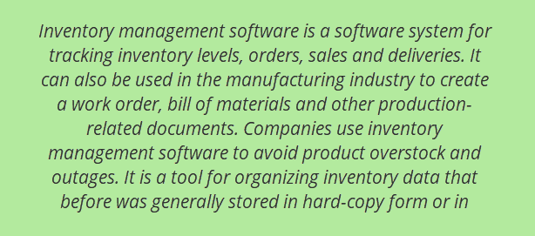There is nothing quite as satisfying in a distribution center as a well-balanced inventory. Orders arrive, orders are shipped, and your fulfillment and delivery flows consistently like the tides. Inventory does not become overstock to take up space and have a negative impact on cash flow. With excellent inventory control, being out of stock of any item is a rare occasion.

Sadly, the perfectly balanced inventory is somewhat of a Zen-like ideal: The moment you identify the inventory as ‘balanced’, it morphs. The best you can do to manage the factors that affect inventory to control overstock or short-stocked items on the warehouse floor.
With some careful planning and a few deft adjustments to inventory management processes, you eventually establish a balance that you can maintain.
How can this be accomplished?
Here are seven ways to reduce your inventory and maintain an ideal flow of products through your distribution center.
#1 - Adopt an MTO Model
The primary method for optimizing your inventory management is to find a means to match the number of sales with production while keeping customer wait time to a minimum.
In other words, any item that can be categorized as a made-to-order item (MTO) is an item that can be sold without inventory on hand because the customer does not expect to receive their purchase before they leave the sales location.
For a Made-To-Order model, take a close look at your inventory and determine which items could potentially be adapted to a MTO distribution model without adding to a customer’s expected wait time.
It is a challenge to determine which items are produced by your company (or distribution client) which can be manufactured, sent to distribution, and delivered to the end user within the customer expected wait time window.
The more items a company can Make-To-Order (MTO), the less inventory you need to keep on hand, and the less likely you are to overstock or go short stocked on an item.
#2 - Switch to Aggregating Inventory
There are two ways to aggregate your inventory for smarter and smaller inventory:
- Item Aggregation and 2. Place Aggregation
Item Aggregation
Here’s how this method works. Say you decide to start by checking your sales numbers to see which items are unpredictable sellers and are also only differentiated by the language on their packaging.
This means that to meet customer demand, you need to keep three SKUs in stock for the same item in case you get an order for a specific language packaging for an item.
The problem is, you need to keep three nearly identical items in stock, and have no way of predicting which will have the higher demand from month to month due to the labeling language variance.
How do you fix it?
Switch to one SKU and multilingual packaging. No matter which language is in demand at any given time, it’s already printed on the box, and you don’t have to keep three separate items in inventory.
Place Aggregation
Sometimes, it’s not just multiple SKUs for identical items that causes overstock and redundancy, but also the number of distribution centers.
While multiple distribution centers concentrated within a few hundred miles of each other seems like a great way to provide superior service and turnaround time on fulfillment, it also requires a significant amount of additional inventory investment to keep those centers stocked.
Aggregate your centers and inventory into fewer locations to reduce the cash tied up in inventory.
#3 - Step Up Replenishment Intervals
This technique is relatively simple to implement. Review your inventory management data and calculate how much stock you need to keep orders moving out the doors without short-stocking. Then reduce that number by increasing the frequency of replenishment intervals to prevent short stocks though there is less inventory on hand. It is simple and can be incredibly effective.
#4 - Economical Order Quantity Models (Be Cautious)
Economical Order Quantity (EOQ) models work well under certain conditions, but are not a one-size-fits-all solution. EOQ models are based on two easily calculable costs and one significantly variable factor that can throw off your entire inventory. Re-ordering and holding costs are generally fixed or vary only slightly for EOQ, but the third variable in the equation, Demand, is about as unpredictable as it gets for some industries. Unless you distribute products with a 100% or near 100% predictable demand, EOQ is not the silver bullet of inventory management many make it out to be.
#5 Stick to Smaller Batch Orders
As with more frequent replenishment, order products in smaller batches to keep your on-hand inventory low, and by the same token your holding costs and the potential for overstock.
Smaller batches negate the need to store a large quantity of inventory and helps with Just-in-Time (JIT), where suppliers can deliver items in a smaller quantity and more frequently.

This technique is not only a benefit to the expiry date of the product, which can be passed straight on to the customer thereby enhancing the product value, it also has copious benefits to quality control.
By using smaller batches, the batches can be controlled better (a larger sampling rate) and, if there is a problem with a batch, the smaller the batch is, the more possible it is to control the outcome efficiently.
#6 - Implement a High-Quality Inventory Management System
Inventory management software with portable inventory workstations and mobile inventory management devices are crucial to monitoring on hand overstock and short-stocks.
Companies often use inventory management software to reduce their carrying costs. The software is used to track products and parts as they are transported from a vendor to a warehouse, between warehouses, and finally to a retail location or directly to a customer.]
Inventory management software is used for a variety of purposes, including:
- Maintaining a balance between too much and too little inventory.
- Tracking inventory as it is transported between locations.
- Receiving items into a warehouse or other location.
- Picking, packing and shipping items from a warehouse.
- Keeping track of product sales and inventory levels.
- Cutting down on product obsolescence and spoilage.
- Avoiding missing out on sales due to out-of-stock situations.

#7 - Never Stop Looking for a Better Way
The process of improving inventory control is ongoing. New SKUs emerge, demand changes like the weather, and new manufacturers and vendors are entering the marketplace every month. Use your inventory management solution to stay ahead of the curve, and always be asking your team for input about how to tweak and adjust the processes to control overstock and prevent short stock. A ‘Zen-like’ balance is achievable, but may require significant changes to how you manage your inventory.